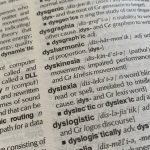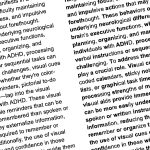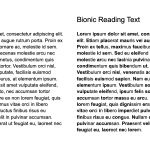Dyslexia, a common learning difficulty, primarily affects the skills involved in reading and spelling. It doesn’t stem from a lack of intelligence or a desire to learn; rather, those with dyslexia often grapple with identifying speech sounds and relating them to letters and words. The introduction of the Bionic Reading method in the digital landscape, which uses visual cues to emphasise vital sections of a text, raises an intriguing question: Can Bionic Reading be a valuable tool for those with dyslexia? This article explores the potential intersection of Bionic Reading and dyslexia.
Dyslexia: A Brief Overview
For individuals with dyslexia:
- Words can appear jumbled.
- Spelling might be challenging.
- Reading aloud may be slower than their peers.
- Comprehending complex sentences can be difficult.
- Given these challenges, any method that can ease the reading process is worth investigating.
Bionic Reading: A Recap
Bionic Reading aims to enhance comprehension by visually marking the most crucial parts of a text. These visual indicators can be in the form of bolding, varying font sizes, or colour highlighting, allowing readers to swiftly identify and internalise main points.
Potential Benefits of Bionic Reading for Dyslexics
Simplifying Textual Complexity: By emphasising key phrases or sentences, Bionic Reading breaks down textual information, making it easier for dyslexic individuals to process content without getting lost in extensive details.
Highlighting Essential Information: Dyslexic readers might find it challenging to determine the primary points in dense paragraphs. Visual cues can guide them directly to the core ideas, streamlining the reading experience.
Encouraging Incremental Reading: Bionic Reading’s visually distinct sections can encourage dyslexic readers to process text in chunks, allowing for pauses and reflections, which can be especially beneficial for comprehension.
Reducing Cognitive Overload: For dyslexic readers, long and unbroken paragraphs can be overwhelming. By visually breaking the text, Bionic Reading can reduce the cognitive load, allowing for a more focused reading experience.
Considerations and Limitations
While Bionic Reading offers potential advantages, some points warrant consideration:
Need for Personalisation: Dyslexia varies in its manifestations. What works for one individual might not work for another. Any implementation of Bionic Reading for dyslexics should be adaptable.
Avoiding Overemphasis: If the text has too many visual cues, it can be counterproductive. The effectiveness of Bionic Reading lies in its subtlety and strategic emphasis.
Complementary, Not Curative: Bionic Reading can aid the reading process, but it’s not a cure or complete solution for dyslexia. It should be combined with other dyslexia-specific interventions.
Conclusion
Dyslexia presents unique reading challenges, and methods that can simplify and streamline the reading process are always welcomed. Bionic Reading, with its visual emphasis on key content, offers a promising avenue. By guiding attention and reducing cognitive strain, this technique can potentially make digital reading more accessible for those with dyslexia. As with all interventions, it’s essential to approach Bionic Reading as a flexible tool, one that can be tailored to individual needs, ensuring optimal benefits for each reader.
Author Profile
Latest entries
 Resources2024.01.25Animals That Start With The Letter N
Resources2024.01.25Animals That Start With The Letter N Bionic Reading2023.09.22Bionic Reading for Dyslexia: A Potential Bridge to Enhanced Comprehension
Bionic Reading2023.09.22Bionic Reading for Dyslexia: A Potential Bridge to Enhanced Comprehension Bionic Reading2023.09.21Bionic Reading for ADHD: Harnessing the Power of Visual Cues to Aid Focus and Comprehension
Bionic Reading2023.09.21Bionic Reading for ADHD: Harnessing the Power of Visual Cues to Aid Focus and Comprehension Bionic Reading2023.09.20Bionic Reading Method
Bionic Reading2023.09.20Bionic Reading Method




